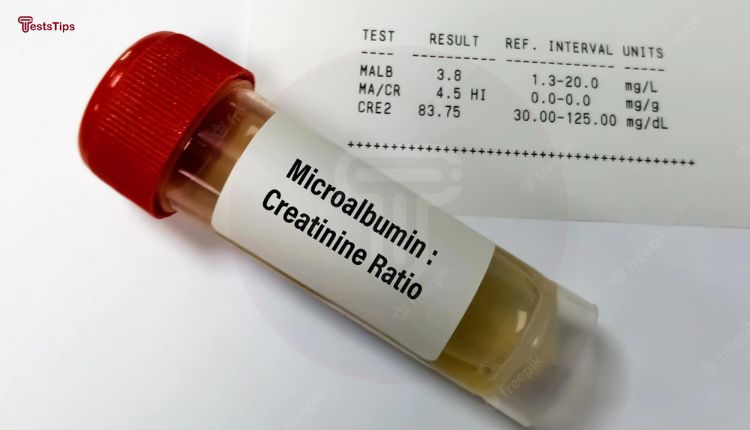Microalbumin Creatinine Ratio. Results and test preparations
Microalbumin Creatinine Ratio (uACR) test
A Microalbumin Creatinine Ratio (MCR) test is used to measure the ratio of albumin to creatinine in urine. Find out who should get this test and why.

Table of Contents
The microalbumin creatinine ratio is a powerful tool for assessing your risk of developing kidney disease. This ratio, which compares urine albumin to the amount of creatinine in your system, can help detect very small amounts of protein in the urine and can be used as an early indicator of kidney damage.
What is a Microalbumin Creatinine Ratio Test?
The kidneys are inside your belly, on either side. If your kidneys start to fail, they may not be able to remove waste from your blood as quickly as they used to. This can cause a build-up of toxins in your blood, including a protein called albumin.
Albumin is a type of protein, and elevated levels of it in the urine can be an early warning sign of kidney damage or disease. So A urine microalbumin creatinine ratio urine test involves measuring small levels of a blood protein (albumin) in your urine.
The urine albumin to creatinine ratio (or MCR) is a lab test that measures the ratio between albumin and creatinine in your urine. In combination with creatinine levels, doctors use this ratio to measure how much albumin is being excreted through your kidneys.
This test detects kidney disease that can occur as a complication of diabetes. Anything above 30 mg/g may mean you have kidney disease, and your doctor may order a creatinine test to confirm the diagnosis.
Other names: uACR, MCR, Urine albumin; albumin-creatinine ratio; microalbuminurea; ACR; UACR
What is the purpose of the test?
The microalbumin creatinine ratio (uACR) test is a test that is used to screen for kidney problems in teens with diabetes.
A microalbuminuria test is also known as the albumin-to-creatinine ratio (ACR) test or the urine albumin test.
A ratio of albumin (mcg/L) to creatinine (mg/L) of less than 30 is normal; a ratio of 30-300 signifies microalbuminuria and values above 300 are considered to be significant.
The microalbumin/creatinine ratio test is a simple and quick way to determine if you have kidney problems. It can help screen for kidney disease that can occur as a complication of diabetes.
When Should a Microalbumin Creatinine Ratio Test be Taken?
If you’re concerned about your kidney health, you may want to ask your doctor to measure your urine albumin-creatinine ratio (uACR). This test is used to identify early-stage kidney disease, and a ratio of albumin (mcg/L) to creatinine (mg/L) of less than 30 is normal. A ratio of 30-300 signifies microalbuminuria and values above 300 are considered high.
If you have any of the following conditions, you may be at risk for high uACR levels:
- Diabetes
- Urinary tract infection.
- Heart disease
- Hypertension
- Obesity
- Muscle mass,
- Smokeing
- Over 50 years old
If you experience any of these conditions, talk to your doctor about getting screened for kidney disease.
Test preparations
The microalbumin-creatinine ratio test necessitates no special preparation. However, before submitting your urine sample, you should avoid the following:
- Intense exercise may temporarily raise the amount of albumin in your urine.
- Eating meat can lower your creatine levels, so you may be asked to refrain from eating it for a day before your test.
Tell your doctor about all of the medications, herbs, vitamins, and supplements you’re taking. If you have signs of possible kidney damage, such as high levels of albumin in your urine, the test is usually performed.
“Related: Lactate Dehydrogenase (LDH) Test. What Does an Elevated LDH Indicate?“
How is a microalbumin creatinine ratio test carried out?
A urine sample for urinary microalbumin to creatinine ratio test can be collected in a variety of ways:
Microalbumin to creatinine ratio random urine sample
It entails taking a single urine sample at any time of day.
An early morning or timed urine sample is taken first thing in the morning or after going four hours without using the restroom.
sample collection method
An early morning or timed urine sample is preferred for a random urine sample. A healthcare professional may give you a small container and instructions on how to collect your urine sample using the “clean catch” method:
- Don’t let the container contact with your skin.
- Urinate for a few seconds into the toilet before stopping the flow.
- Urinating once more, into the container.
- Fill the container with at least an ounce or two of urine (pee).
- The container should be labeled with the amount of urine required.
- Complete your urination in the toilet.
- Replace the container’s cap and return it as directed.
Follow the instructions included in your collection kit.
A 24 hours urine sample
It is necessary for you to collect all of your urine over the course of a 24 hour period. This test is typically used to investigate abnormal results from a single urine sample test.
The most accurate method for measuring albumin in the urine is a 24-hour urine test.
sample collection method
You will be given a special container to collect your urine over the course of a day and instructions on how to collect and store your sample for a 24-hour urine sample. In general, the following steps are included in the test:
- To begin, urinate normally in the toilet. This urine must not be collected. Make a note of when you urinated.
- Collect all your urine in the container for the next 24 hours.
- During the collection period, keep the urine container refrigerated or in an ice-filled cooler.
- If possible, try to urinate 24 hours after beginning the test. This is the final collection of urine for the test.
- As instructed, return the container containing your urine to your provider’s office or the laboratory.
Are There Any Risks Associated With the Test?
There are no known risks associated with submitting microalbumin to creatinine ratio urine sample.
What do the findings imply?

If your micro albumin:creatinine ratio reveals an abnormal amount of albumin in your urine, you will most likely require additional testing to confirm your findings. Certien conditions can cause temporary increases in albumin levels such as:
- Exercise
- Certain medications
- Fever
- Inflammation in the body.
Typically, you will have two more tests within three to six months of your initial test. If two of three tests reveal abnormal albumin levels in your urine, you may have early-stage kidney disease.
Higher or increasing levels of albumin in your urine usually indicate:
- More serious kidney disease that will likely worsen faster.
- A higher risk of developing heart and blood vessel problems (vascular diseases).
A lower level of albumin in your urine does not always indicate kidney disease. Other inflammatory conditions that can cause an increase in albumin in urine include:
- Infections of the urinary tract
- Infections of the gums (periodontitis)
- Hepatitis
Your test results may also be influenced by your muscle mass, diet, age, and race.
If your results are abnormal, your doctor will usually order additional kidney tests, including a blood test called an estimated glomerular filtration rate (eGFR). Discuss the significance of your test results with your provider.
Related tests
- Creatinine Test
- Urine analysis
- Complement C3
- Complement C4
- Comprehensive Metabolic Panel (CMP)
- Glomerular Filtration Rate (GFR) Test
- Protein in Urine
By knowing your uACR level and taking measures to prevent or lower the risk for high levels, you can continue to have healthy kidney function.
